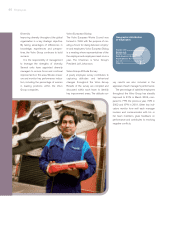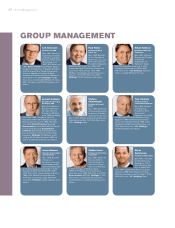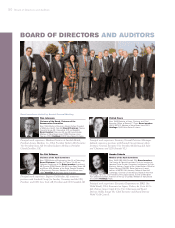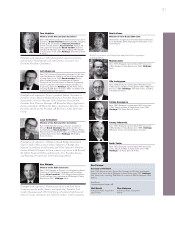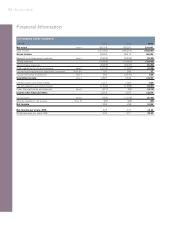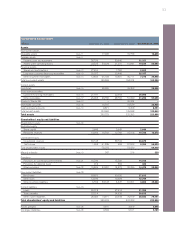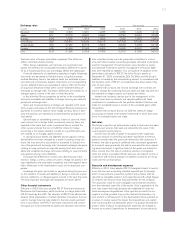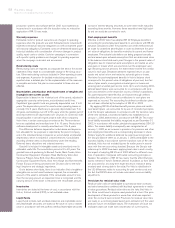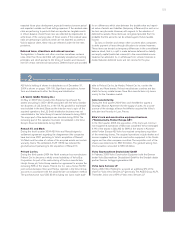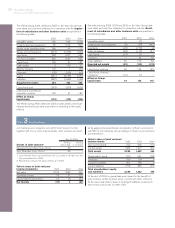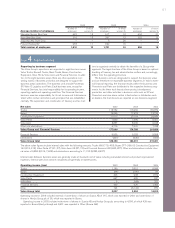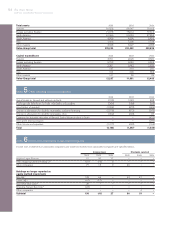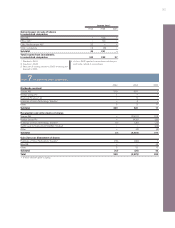Volvo 2004 Annual Report Download - page 58
Download and view the complete annual report
Please find page 58 of the 2004 Volvo annual report below. You can navigate through the pages in the report by either clicking on the pages listed below, or by using the keyword search tool below to find specific information within the annual report.
56 The Volvo Group
Notes to consolidated financial statements
The consolidated financial statement have been prepared in
accordance with the principles set forth in the Recommendation of
the Swedish Financial Accounting Standards Council, RR 1:00,
Consolidated Financial Statements and Business Combinations.
All business combinations are accounted for in accordance with
the purchase method.
Companies that have been divested are included in the consoli-
dated financial statements up to and including the date of divest-
ment. Companies acquired during the year are consolidated as of the
date of acquisition.
Joint ventures are preferably reported by use of the proportionate
method of consolidation. A few joint ventures are reported by use of
the equity method due to practical reasons.
Holdings in associated companies are reported in accordance
with the equity method. The Group’s share of reported income after
financial items in such companies, adjusted for minority interests, is
included in the consolidated income statement in Income from
investments in associated companies, reduced in appropriate cases
by amortization of goodwill. The Group’s share of reported taxes in
associated companies, is included in Group income tax expense.
For practical reasons, most of the associated companies are
included in the consolidated accounts with a certain time lag, nor-
mally one quarter. Dividends from associated companies are not
included in consolidated income. In the consolidated balance sheet,
the book value of shareholdings in associated companies is affected
by Volvo’s share of the company’s net income, reduced by the amor-
tization of goodwill and by the amount of dividends received.
Accounting for hedges
Loans and other financial instruments used to hedge an underlying
position are reported as hedges. In order to apply hedge accounting,
the following criteria must be met: the position being hedged is iden-
tified and exposed to exchange-rate or interest-rate movements, the
purpose of the loan/instrument is to serve as a hedge and the hedg-
ing effectively protects the underlying position against changes in
the market rates. Financial instruments used for the purpose of
hedging future currency flows are accounted for as hedges if the
currency flows are considered probable to occur.
Foreign currencies
In preparing the consolidated financial statements, all items in the
income statements of foreign subsidiaries and joint ventures (except
subsidiaries in highly inflationary economies) are translated to
Swedish kronor at the average exchange rates during the year (aver-
age rate). All balance sheet items except net income are translated
at exchange rates at the respective year-ends (year-end rate). The
differences in consolidated shareholders’ equity arising as a result of
variations between year-end exchange rates are charged or credited
directly to shareholders’ equity and classified as restricted or unre-
stricted reserves. The difference arising in the consolidated balance
sheet as a result of the translation of net income, in the income
statements, in foreign subsidiaries’ to Swedish kronor at average
rates, and in the balance sheets at year-end rate, is charged or cred-
ited to unrestricted reserves. Movements in exchange rates change
General information
Amounts in SEK M unless otherwise specified. The amounts within parentheses refer to the two preceding years; the first figure is for 2003
and the second for 2002.
Note 1Accounting principles
The consolidated financial statements for AB Volvo (the Parent
Company) and its subsidiaries have been prepared in accordance
with generally accepted accounting principles in Sweden (Swedish
GAAP). Accounting standards and interpretations issued by the
Swedish Financial Accounting Standards Council have thereby been
applied. Swedish GAAP differs in significant respects from US
GAAP, see further in Note 34.
In the preparation of these financial statements, the company
management has made certain estimates and assumptions that
affect the value of assets and liabilities as well as contingent liabil-
ities at the balance sheet date. Reported amounts for income and
expenses in the reporting period are also affected. The actual future
outcome of certain transactions may differ from the estimated out-
come when these financial statements were issued. Any such differ-
ences will affect the financial statements for future fiscal periods.
Changes of accounting principles
Effective in 2005 Volvo will adopt International Financial Reporting
Standards (IFRS) in its financial reporting. The transition from
Swedish GAAP to IFRS is being made according to a regulation
applicable to all listed companies within the European Union as of
2005. A more detailed overview of the transition to IFRS is presented
on pages 108–115.
No changes of accounting principles have been made during
2004.
As of 2003, Volvo has adopted RR 29 Employee Benefits in its
financial reporting. RR 29 Employee Benefits conforms in all signifi-
cant respects with IAS 19 Employee Benefits issued earlier by the
International Accounting Standards Committee (IASC). Effective in
2003, Volvo has adopted RR 27 Financial Instruments: Disclosure
and Presentation, which conforms to a large extent with IAS 32
issued by the IASC. The adoption of RR 27 has affected the balance
sheet presentation of certain derivative instruments that are used to
manage financial risks related to financial assets and liabilities.
As of 2003, Volvo has also adopted RR 22 Presentation of
Financial Statements, RR 24 Investment Property, RR 25 Segment
Reporting – Sectors and Geographical Areas, RR 26 Events after
the Balance Sheet Date and RR 28 Government Grants. Certain
changes have been made in the structure and content of the finan-
cial information as from 2003, as a result of these new standards.
However, the standards listed above have not resulted in any
changes of the measurement of the Group’s financial performance
or position.
Consolidated financial statements
The consolidated financial statements comprise the Parent Company,
subsidiaries, joint ventures and associated companies. Subsidiaries
are defined as companies in which Volvo holds more than 50% of
the voting rights or in which Volvo otherwise has a controlling influ-
ence. However, subsidiaries in which Volvo’s holding is temporary are
not consolidated. Joint ventures are companies over which Volvo has
joint control together with one or more external parties. Associated
companies are companies in which Volvo has a significant influence,
which is normally when Volvo’s holding equals to at least 20% but
less than 50% of the voting rights.


